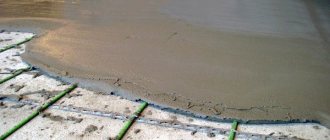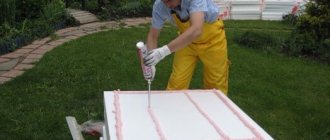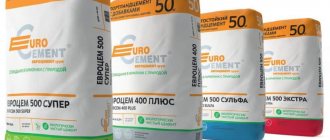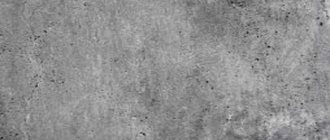The service life of the concrete mixture depends on the quality of the solution and the manipulations carried out to protect it from external influences. Concrete varnish is a special product designed to protect the internal and external surfaces of structures from negative influences such as ultraviolet rays, attack by chemical elements or precipitation. The advantages of varnish coating are long service life, frost resistance, moisture resistance and respectable appearance.
Types and compositions of quality coatings
Polyurethane
The undeniable advantage of the substance is its complete resistance to water (moisture). It will be relevant to use the product in conditions with high air humidity. Polyurethane varnish is used for external treatment of facades, swimming pools, paving slabs made from natural or synthetic raw materials.
This coating does not allow water to pass through at all.
Polyurethane enamel is a solution that contains oligomers and polyurethane components. The total mass of the substance includes an organic component, due to which during the hardening process the product forms a protective, transparent film. It is possible to add pigmenting particles to the varnish composition, which will give the material the required color.
Polymeric
A coating that performs protective functions is applied to structures that have a mineral base, such as brick and concrete. A positive feature of the product is its decorative use and increased resistance to wear. This is the only varnish that achieves the effect of wet stone. Distinctive qualities:
- abrasion resistance;
- strength;
- moisture resistance;
- resistance to chemical influence.
This coating gives a beautiful wet effect.
The varnish substance is used for all types of exterior work. It is possible to pigment the material. The structure coated with the substance does not lose color and helps maintain load-bearing capacity. The composition is based on single-component ingredients, which makes it possible to dry in a shorter time than other products. The peculiarity is determined by the minimal content of water components.
Silicone and acrylic types
Concrete varnish - acrylic or silicone, used in work for treating residential premises.
Expensive protective agents among paints and varnishes. Professionals recommend using it for interior work; the area of use is explained by the pricing policy. Although the composition of the product has high performance indicators, it is not advisable to use the product for treating external structures, since cheaper analogues will cope with the protective function. When dry, silicone or acrylic varnishes give the treated structure a transparent color with a matte sheen.
Water-based products
This product also gives a slight glossy effect after application to the selected surface.
Rarely used for processing concrete structures. These varnishes are usually used to coat wooden products and decorative concrete. The protective agent creates a colorless glossy layer on the surface. As a rule, the solution is presented in the form of a two-component polyurethane product, which is used to coat concrete. For example, the popular PaliStone brand is particularly popular among buyers.
Recommendations
When working with concrete, it is better to use polyurethane products. It would be justified to apply it to the foundation and load-bearing walls, since the substance has the highest protection against moisture among other varnishes.
Acrylic and silicone substances are excellent for products made of artificial materials and interior wall decoration. They enhance aesthetic appearance and provide enhanced protection.
Polymer varnish is much cheaper and has the widest application. Can be used both for exterior work and for interior finishing of any materials.
Famous manufacturers
Modern industry offers the buyer a wide range of paints and varnishes. Examples are presented in the table:
| Brand and type | Properties | Application |
| "Texol" - polymer varnish for concrete | Versatility and ease of use at work | Concrete, brick, stone |
| Moisture and wear resistance | ||
| "Tistrom" is a one-component polyurethane product | Chemical resistance, hydraulicity | Brick, metal stone |
| Resistance to mechanical stress | ||
| Strong - silicone | Hardening, waterproof effect | For interior work with stone |
| "Dali" - acrylic-silicone varnish | Shockproof properties, moisture resistance | For stone and brick surfaces |
Application
It should not be forgotten that all of these varnishes are synthetic mixtures. Therefore, personal protective equipment will not hurt. When carrying out interior work, as well as after completion of treatment, the premises must be thoroughly ventilated.
The surface to be treated should first be prepared for painting: cleaned, dusted, dried, possibly degreased, primed. The maximum air temperature during work should not exceed +35°.
The quick-drying polymer composition can be applied by brush or roller, also by airless or pneumatic spraying. In the last two cases, the substance should be diluted to working viscosity. Acrylic, polyurethane, silicone varnishes are also applied with a similar painting tool.
It is recommended to cover the surface to be treated with at least two layers, especially if the surface of the stone has a porous structure.
Varnishes for mineral materials extend the life of the room or the building itself. Therefore, it is so important to approach the choice of product with special care. Before purchasing, you need to determine which of the proposed varnishes is more suitable for your case, calculate the consumption, costs of preparation and execution of the work. Special varnishing of concrete and stone surfaces will provide long-term and high-quality protection during operation.
Areas of application of protective equipment
Such finishing materials can be used in parking areas.
Varnish for concrete and stone is the optimal chemical for extending the life of a building structure. The paint and varnish substance protects concrete surfaces from many factors of destruction. It is used in all areas of construction, and mainly for fencing buildings made of concrete, large warehouses, hangars, parking lots and parking lots. The varnish is also used for production facilities that belong to the industrial or pharmaceutical fields, to cover structures that are susceptible to climatic influences, such as bridges, walking paths, squares, parks.
Water-based concrete varnish is used for interior and exterior work. This product is used to treat decorative surfaces made of stone and brick, floors and other structural elements with a concrete base.
Features of selection, by what criteria
Knowing the types of products and features, it is still difficult to decide on the choice of the best varnish, because there are a large number of compositions on the construction market. The following selection criteria should be taken into account:
- You shouldn’t try to save a lot; reliable protection can only be created by high-quality products, usually this applies to well-known brands;
- You can focus on brands that are especially popular. Now these are Texol, Tistrom;
- Look at the varnish consumption indicator to calculate the required volume of varnish;
- They think in advance what protective properties will be needed: the level of moisture resistance, wear resistance, resistance to low and high temperature influences, etc. When choosing, study the label, which states the technical characteristics of the varnish product;
- Decorative features described above are the effect of matte and gloss. Usually, matte types are chosen for interior work, glossy ones for exterior work, or neutral options are used - semi-matte varnishes.
You shouldn’t try to save a lot; only high-quality products can create reliable protection.
Varnishes for concrete bases can give a beautiful external effect and will also serve to extend the service life of the material. An additional layer is created that does not allow water to pass through and withstands other negative impacts during operation. If varnishing is carried out according to the rules, the coating will please the eye for a long time.
How to properly treat surfaces?
The correct application technology is responsible for the further performance of concrete varnish. When processing large areas, you need to divide the work front into separate parts, namely, process the surface one at a time, without interrupting the process. The first stage of coating is to clean the surface from dust and other contaminants. Before applying varnish, the structure should be primed using special compounds. And only after all these manipulations should you start applying the paint and varnish substance. This can be done using a wide brush, roller or spray. After application, give the product time to dry completely.
Penetration
Penetration is a very important stage. If you varnish the concrete directly, you will use a lot of it and risk poor adhesion of the varnish, which will quickly crack.
Pre-penetration is affordable, and its use can significantly reduce the consumption of more expensive varnishes. This pre-coat provides bonding and surface protection. This will make it easier to apply the paint. Penetrate with a brush, not a roller.
Concrete varnish based on polyurethane
Among all varieties, the most popular is polyurethane varnish. Its properties include impeccable penetration into microcracks in concrete and its protection. To achieve an even greater effect, polyurethane-based impregnation is sometimes used first.
The use of this particular protection best prevents moisture from entering the surface layers of concrete. In addition, polyurethane varnish has excellent wear resistance. Another advantage is the relatively low prices - 150-200 rubles per kilogram.
The best polyurethane varnish for this model is the Tistrom brand product. This product is most suitable for coating in car repair shops, workshops, garages and other similar buildings. Its advantages are almost completely identical to the above. However, there are differences. Tistrom polyurethane varnish has the following characteristics:
- resistance to oil products;
- ease of use;
- creating a good decorative effect;
- does not wash off, is not damaged and does not lose its protective qualities during wet cleaning.
The average cost for Tistrom polyurethane varnish is 310 rubles per 1 kilogram.
We deliver throughout Moscow and Russia!
You can receive your product tomorrow! After placing your order, a manager will contact you to agree on delivery terms.
Delivery times and times:
- Orders placed before 17:00 - on the next business day (for some products after one business day)
- Orders placed after 18:00 after business hours or on weekends - after one business day (in some cases after two)
- Possibility of order delivery same day (to be agreed with the operator)
Low shipping costs!
- Delivery 400 rub. for orders from 1800 rub. (Moscow + 5 km from MKAD)
- Delivery 800 rub. for orders up to 1800 rub. (Moscow + 5 km from MKAD)
- Free delivery from RUB 10,000. (except for products in the “Plumbing” category)
Related discussions
Unfinished concrete ceiling - leave as is
3675839?n=4 If you don’t currently have concrete, but you want to give it the appearance of concrete, then now there are many decorative plasters for concrete










